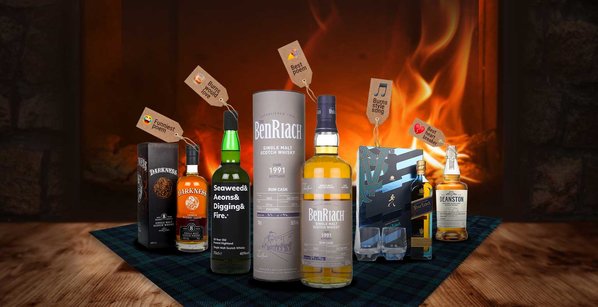The complete Whisky Glossary
Curated by our in-house whisky experts and writers
ABV
Alcohol by volume. The alcoholic strength measured as the percentage of alcohol present.
Ace'd
A term coined by Bruichladdich, meaning Cask Finish. It is an acronym for Additional Cask Enhancement. (See Cask Finish).
Aftershots
See Feints.
American Oak
Also known as White Oak or by the binomen Quercus Alba, American oak is widely used in whisky cooperage. American Oak has a high vanillin content. It is also fast growing and possesses high content of lactones.
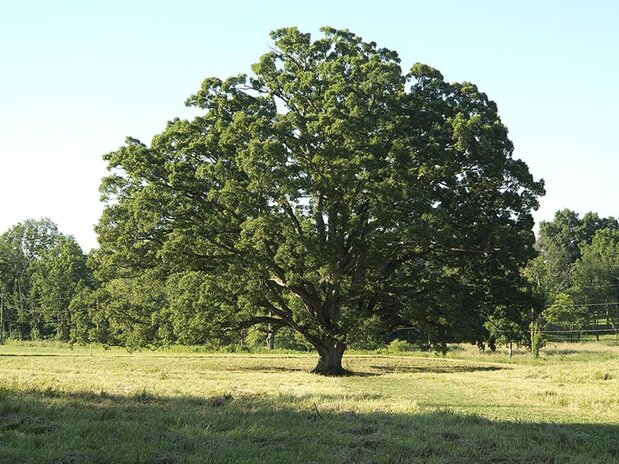
Amylase
An enzyme used in a mash tun to convert the starch into maltose.
Aunteron
A doppelganger with the capability to supplant a person, often malevolent.
Backset
An American term for the liquid at the bottom of the stills after distillation. This is added to the Washback and the Mash Tun to prevent bacterial contamination.
Balance
The composition of a whisky, in terms of flavours and how well they go together. One might remark upon the superb Balance of a whisky from Ardbeg, with just the right amount of sweetness to combat the intensity of the peated malt.
Barley
A cereal grain which is oft used in the production of whisky, and used exclusively in single malt whisky. Various strains of barley are used in whisky production, all hail from the grass Hordeum vulgare.
Barm
See yeast.
Balance
The composition of a whisky, in terms of flavours and how well they go together. One might remark upon the superb Balance of a whisky from Ardbeg, with just the right amount of sweetness to combat the intensity of the peated malt.
Barrel
A large wooden vessel used to store maturing spirit. In the whisky world these must be made from Oak. They are built by coopers and are of varying sizes, depending on the industry. A standard whisky barrel has a capacity of approximately 40 gallons (180 litres). The larger the barrel, the less wood contact with the spirit. So, a smaller barrel, in theory, can mature whisky faster.
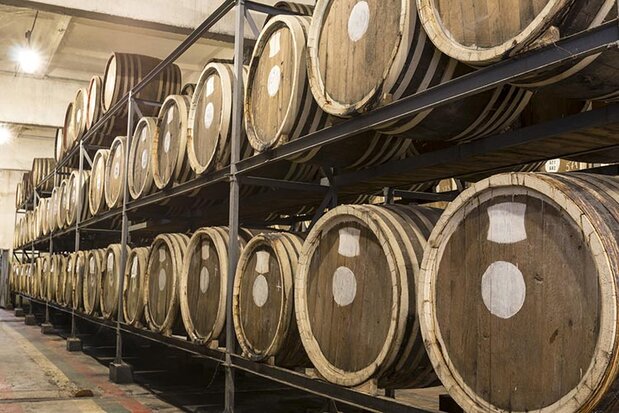
Beer still
An American term for a wash still.
Beer
An alcoholic beverage brewed from fermenting cereal grains. A liquid can only be distilled if there is alcohol present, thus the production of beer is the first stage in the production of whisky.
Bere barley
Bere Barley (aka Beir or Bear): A variety of six-row barley, mainly to be found on the Isle of Orkney. It is believed to be the oldest cereal to remain in continuous cultivation in the British Isles. The Vikings are credited to have brought the bere grain to Britain during the 9th Century AD.
Blended malt
A vatting of malt whiskies from more than one distillery.
Blended Whisky
Malt whisky combined with grain whisky. By law there must be a minimum of 40% malt whisky.
Explore blended whisky from around the world.
Try some blended scotch whisky.
Try some blended malt scotch whisky.
Blending
The act of combining one liquid with another. Save for single cask whisky, blending is an important part of whisky production, particularly so in the production of single malt, where a selection of casks are blended together bringing various desirable characteristics to the finished product.
Bond
Storage facilities in which whisky is held before the excise duty is levied.
Bottled in bond
- A term which states that excise duty has been paid.
- An American term which refers to whiskey that has been aged and bottled according to the stipulations laid out by the ‘Bottled-in-bond Act of 1897’. The whiskey must be the product of a single distillation seasons, from one distiller at a single distillery. It must be held for at least four years in a federally bonded warehouse and bottled at 50% abv.
Bourbon
An American whiskey distilled from a minimum of 51% corn, distilled to no more than 80% abv, filled into new charred oak barrels at no more than 62.5% abv.
Explore our huge range of Bourbon Whiskey here.
Popular Bourbon brands that we stock include: Jack Daniels bourbon whiskey, Jim Beam bourbon whiskey, Blanton's bourbon whiskey and Woodford Reserve whiskey.
Brewing
The act of mashing cereal grains in hot water and adding yeast to promote fermentation.
Burr oak
A species of Oak native to North America and some parts of Canada. Also known as Bur Oak, Mossycup Oak and Mossycup White Oak, with the binomen Quercus Macrocarpa. A fast growing Oak often marketed as White Oak, Burr Oak has been used to mature whisk(e)y, an example being Glenmorangie Burr Oak.
Butt
A butt is a large cask for maturing alcoholic beverages, made from oak, with capacity for 105 gallons (477.3 litres) – roughly twice that of a hogshead. These are often used for sherry maturation.
Capacity
In whisk(e)y distillery terms, the capacity is the amount of pure alcohol (in litres) that a distillery can turn out a year.
Cask finish
The term refers to the maturation of whisk(e)y. When a whisky is transferred from the primary barrel to a secondary, or even tertiary, for an additional maturation, it is known as a Cask Finish. Of late, there has been a massive influx of ‘finished’ malts. Often the additional cask used is more ‘exotic’, and examples include Sauternes Cask Finish and Rum Cask Finish. Cask Finishing is fraught with much controversy, as purists argue it is not traditional and the finished spirit ceases to be a Single Malt. Proponents argue it allows for more variation and helps modernise the industry.
Read more about Cask Finishing in whisky here.
Cask
The barrel in which whisky is matured. By law, casks must be made from oak.
Chalice
A strain of barley. It is famously used by the Bruichladdich distillery on Islay.
Charring
The act of firing the interior of an oak cask. This technique is of key importance in the production of bourbon and a charred barrel imparts a sweetness to the spirit as well as vanilla.
Chill-filtration
A method of filtering whisk(e)y employed to remove residue and a cloudiness which appears when the spirit reaches lower temperatures. Chill-filtration involves chilling the spirit to between -10 and 4°C and then passing it through a very fine filter. At such temperatures the fatty acids, proteins and esters compound as large clumps which are too large to pass through the filter. This method is highly controversial for it is said to remove flavour and body from the whisk(e)y.
Read more about Chill-Filtration here in our ultimate whisky guide.
Chocolate malt
Malted Barley that has been more heavily kilned. It is used in the production of sweet stouts and ports. It contains no enzymes.
Coffey still
An enhanced version of the continuous still. It was enhanced and then duly patented in 1831 by the Irishman, Aeneas Coffey.
Column still
See continuous still.
Commercial malting
Malting down an industrial scale.
Condensation
The physical change of a substance, from gas to liquid.
Congeners
Chemical compounds, impurities formed during fermentation. It is said that these proffer the majority of characteristics present in whisk(e)y.
Continuous Still
A distillation device which involves constant distillation and re-heating of an alcoholic liquid. This is an extremely efficient method of distillation and the distillate can be as high as 96% abv, though the spirit retains less character, thus is not favoured for whisk(e)y production.
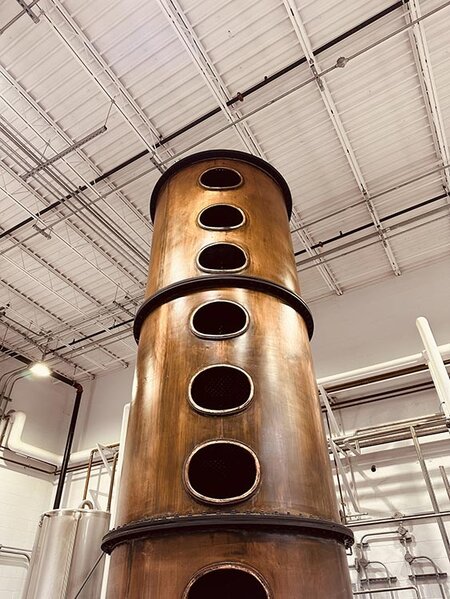
Cooper
A person who builds oak casks for the maturation of spirits and other beverages.
Cork oak
A species of oak native to southwest Europe and northwest Africa, with the Latin binomen Quercus Suber. They are widely cultivated for their high content of Suberin, a water resistant substance, thus are used as bottle stoppers. Cork can be harvested from the Cork Oak every 9 to 12 years and harvesting does not damage the tree.
Corn
A grain used in whisk(e)y production, particularly favoured in America, and in the production of Bourbon, in particular; Bourbon must be distilled from at least 51% corn. Corn was native to America when the first settlers arrived. It contains high levels of starch and protein. Of all grains, Corn proffers the highest yield of alcohol. It gives a corn whisky a gentle sweetness, spice and an earthen character.
Browse our fine selection of American Corn whiskies here.
Looking to try corn whiskey? Take a look at our Corn Whiskey sample sets.
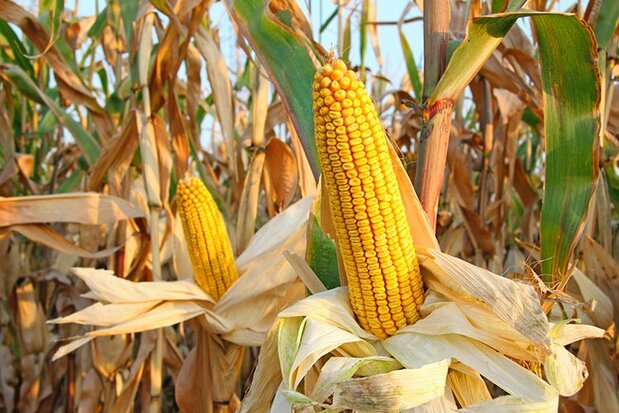
Cytase
Cytase is an enzyme present in cereal grains which breaks down cell walls and allows access to starch.
Distillation
The process of heating an alcoholic substance until the alcohol evaporates. The alcohol is then condensed. This is the basis of all spirit production and relies on the fact that alcohol evaporates at 78.29°C, below the boiling point of water, thus should the right heat be applied the alcohol will evaporate without the water and, when condensed, one is left with a far more alcohol liquid.
Read more about whisky distillation in our guide to 'how whisky is made'.
Double distillation
A process whereby an alcoholic liquid is distilled twice, this is standard practice in whisk(e)y production, save for a few examples, including, though not limited to, the Scottish Lowlands and Irish Whiskey.
Doubler
A second pot still used for a second distillation.
Draff
A term originating from Scotland. Draff is a term for used cereal grains which are no longer useful in the production of alcohol. Rather, draff is used for livestock feed.
Dram
Dram: A Scottish term for a measure of spirits, particularly whisky. The term is said to originate from the Greek ‘Drachma’ which refers to the apothecary measurement of sixty grains, equal to 1/8 ounce.
The phrase has been popularised in recent years by Drinks by the Dram, whose sample ‘drams’ we use to power our Pour & Sip whisky subscription service.
Why not check out our range of drams, samples and miniature whiskies here?
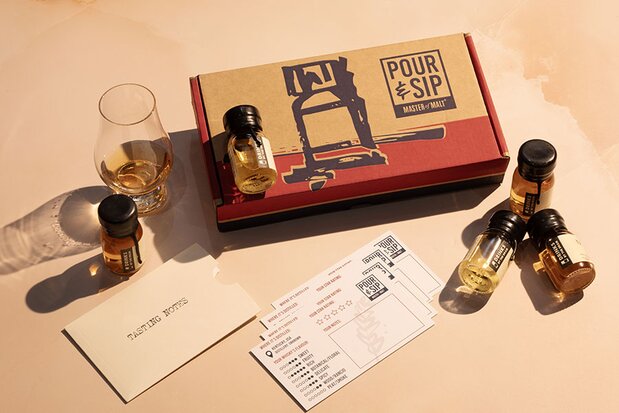
Drum malting
The modern method of malting barley. It entails a large drum which is turned constantly until the malting process is complete.
Dunnage Warehouse
A traditional type of warehouse. These are quite short buildings, with a slate roof, an earthen floor and thick walls made of stone or brick. These are stacked no more than three barrels high and provide superior air circulation. The floor allows more moisture and thus higher humidity. This are said to provide a better whisky, though running costs are much higher, and barrels must be hand moved.
Enzymes
Catalyzing biomolecules. In whisk(e)y production, enzymes are present within cereal grains which convert starch into a fermentable substance. Malting increases the incidence of enzymes.
European Oak
Type 1. Also known as Pedunculate Oak, or by the binomen Quercus Robur and found widely across Europe. This is oft used in brandy and sherry cooperage. It is fast growing with high levels of tannins.
Type 2. Sessile Oak, known by the binomen Quercus Petraea, is often used in wine cooperage. This is slower growing than Quercus Robur, with finer tannins and a high vanillin content.
Evaporation
The physical change of a substance, from liquid to gas.
Excise duty
A tax imposed on produced spirits.
Exciseman
An Officer of H.M. Customs and Excise. An Exciseman is responsible for regulating the manufacturers’ operations and payment of Excise tax.
Feints
The unusable end of a distillation run, unpotable even to the most hardened drinker (also known as Tails or Aftershots).
Fermentation
The conversion of sugar into carbon dioxide and ethyl alcohol with the addition yeast enzymes. The yeast is a living organism which feeds upon the sugar, the carbon dioxide and ethyl alcohol are by-products. When the alcoholic content reaches a certain level, the yeast dies.
Fermenter
See Washback.
Finish
The flavour of a whisk(e)y after is has been swallowed. The finish is measured in length, meaning how long the flavour is retained. Usually, a longer finish is preferred.
Finished
See Cask Finish.
Floor maltings
Floor Maltings are buildings at a distillery in which barley is malted by hand. These are very rare as the process can now be done industrially, without being so labour-intensive. The Bowmore distillery is an example of a distillery whose floor maltings are still in use.
Foreshots
The first part of the second distillation run (also known as Heads).
Golden promise
A type of barley first available in 1968. It boasts a sturdy straw as well an early maturation (as early as July, compared to Optic barley’s August harvest time). It was massively popular and peaked when it enjoyed 90% of the barley market share during the 1970s. It has since been overtaken by newer strains of barley, but continues to be the sole choice for the Glengoyne and Macallan distilleries.
Green malt
Green Malt is barley that has begun the process of germination, though it has yet to bet dried.
Grist mill
A device used to grind barley into flour.
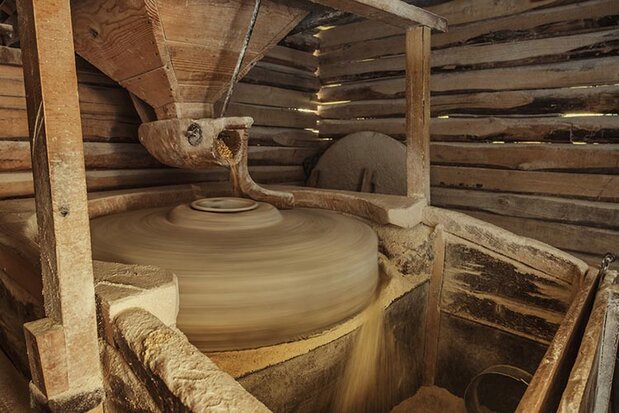
Grist
A flour used in the Mashing process. Grist is produced by finely grinding malted barley.
Hard water
Water with a very high mineral content. Usually this consists of calcium and magnesium ions. Hard Water occurs when the water travels over soft rock.
Heads
See Feints.
Heart
The middle part of the first distillation.
Hogshead
A large barrel, made from oak and used to mature spirit. The capacity of a hogshead was standardized first in an act of Parliament in 1423. The size now varies depending on the industry, for example a Sherry hogshead is slightly larger than a standard Madeira barely. A wine hogshead of today is around 52.5 gallons (238.7 litres).
Kentucky bourbon
Bourbon can be produced anywhere in America, though Kentucky is the only state which can put the name of the state on the label.

Kiln
An area for drying malted barley using hot air. Traditionally, a Scottish kiln was heated by burning peat, thus proffering the strong peaty taste so oft associated with Scotch whisky, particularly that from Islay.
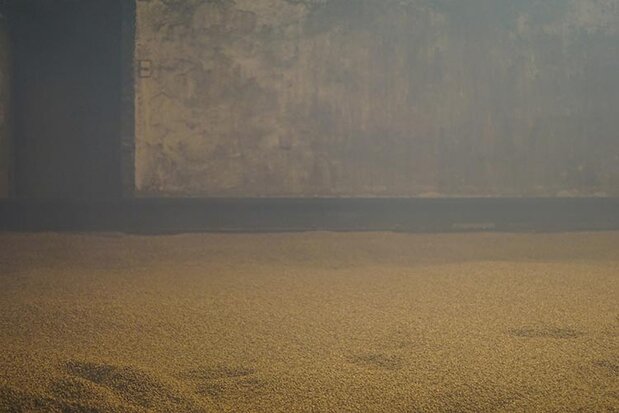
Kilning
The process of drying malted barley to prevent further germination of the barley, retaining the correct amount of starch.
Lauter
Following Mashing, the Mash is transferred to a Lauter, which is a vessel with a sieved bottom.
Lomond still
The Lomond Still is a type of modified pot still. It proffers a heavier spirit. There is an additional condenser fitted at the head of the still. It was first developed in 1955 by a chemical engineer from Hiram Walker, by the name of Alistair Cunningham. It was created to allow the production of whiskies of varying character at one distillery, thus allowing a single distillery to provide a blender with a range of blending components.
Low wines
Low Wines are produced in the first distillation in a Wash Still.
Lyme arm
An arm which extends from the top of the still, connecting the still with the condenser.
Malt
Barley which has been afforded a partial germination before kilned. The malted barley is then ground to a fine flour, or grist.
Mash Bill
A Mash Bill is the list of grains and proportions thereof in American whiskey production. A Mash Bill will typically consist of three or four grains including Corn, Wheat, Rye and Barley.
Mash Tub
See Mash Tun.
Mash Tun
A large vessel in which the grist is combined with hot water thus allowing the fermentable sugars to dissolve.
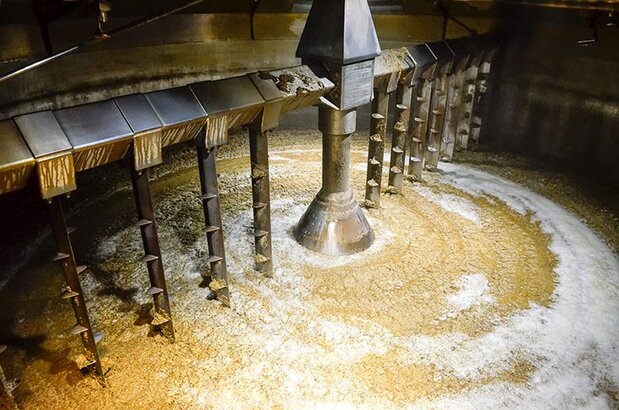
Mash
- The process of steeping mixing Grist with hot water to release the sugars which are present in the grain.
- The term for the mix of Grist and hot water.
Mashman
A distillery worker who tends to the Mash Tun.
Master Blender
The chief blender, it is his or her job to mix the whisk(ie/ey)s together and maintain a consistent product. A skilled master blender can produce a whisk(e)y wherein the sum is greater than the parts.
Maturation
The ageing process of whisk(e)y. Whisk(e)y can only be aged within an oak cask, it is widely believed that whisk(e)y does not age in the bottle.
Micro distilleries
The advent of the Micro distiller is a more recent happening. A Micro distillery is a small scale operation, with few expenses spared, is focuses on quality over quantity.
Monkey lump (aka Monkey Shoulder)
The hunch that develops on the backs of distillery workers who spend a great deal of their time manually turning barley during the malting process.
New Make
Newly distilled spirit, ‘fresh off the still’. It is not yet whisk(e)y for it has yet to undergo the minimum maturation in oak.
Browse our fine selection of new make spirits here.
Nose
- n The aroma of a whisky.
- v To nasally sample a whisky.
Nosing
The act of nasally enjoying a whisk(e)y. Many believe this to be the most important aspect of sampling a delicious whisk(e)y.
Oak
The variety of wood used as a material for building barrels, as well as a number of other items used during the production of whisk(e)y. Oak is from the genus Quercus and there are roughly 400 species. Oak is native to the Northern Hemisphere. Is quite a dense wood with superb strength. It also has a high tannin content. Present within oak are vanillin, among other flavour compounds, and the effects of ageing in oak upon the finished whisky are very high.
Optic Barley
Oxidation
The reaction of whisky with oxygen, or, more broadly, the air. This is alters the flavour of whisky and there is much debate as the effects of oxidation upon an open bottle of whisky, or indeed whether a whisky matures in the bottle. Certainly, when Nosing a whisky the aromas develop after being exposed to the air.
Pagoda
A cosmetically pleasing square pyramid roof that ventilates the malting rooms. It was designed by Charles Doig who was inspired by Japanese architecture. Doig built the first in 1889, which graces the Dailuaine distillery.
Palate
Part des anges
See Angel’s Share.
Peat
A dark, partially decayed organic matter formed in the wetlands. It is formed when full decay is arrested by acidic conditions, and when oxygen is not present. Over thousands of years of decomposition it becomes a flammable substance, traditionally used to fire the malted barley kilns. Its flavour is very intense and is oft associated with tar, bitumen and medicinal notes and due to the high incidence in the locality, it is much associated with whisky from Islay. It is measured in Phenol parts per million. As an example, Laphroaig, a peaty whisky from Islay, is ‘peated’ to around 35ppm.
Explore and learn more about Peaty Whiskies here.
Peated malt
Malted barley which retains a strong peaty-character after it is kilned over peat fires.
Phenols
Also known as carbolic acid, Phenols are the chemical presence of peat and impart tar, bitumen and medicinal flavours. Phenols are of the love or hate order, with an utterly distinctive flavour.
Pipe (aka Port Pipe)
A large barrel, made from oak and used to mature alcoholic beverages. A pipe is of roughly the same size as a butt (105 gallons/477.3 litres), though the size varies depending on the industry. For example, a Port Pipe is roughly 115 gallons, as opposed a standard Madeira pipe, of just 92 gallons.
Pot Still
A traditional still used to distil single malt whisky, among other varieties. Pot Stills are almost exclusively made of copper and are based upon the alembic still, created around the eighth century AD by the Arabian alchemist Jabi ibn Hayyan. Alcohol liquid is heated to a temperature at which the alcohol evaporates, though below the temperature at which water evaporates. Thus the gaseous vapours are more concentrated with alcohol. They are condensed at the top of the still and the spirituous liquid is collected. The term alembic derives from the Arabic ‘Al-inbiq’ or ‘still’, itself from the Greek for cup, ‘Ambix’. Whilst we’re enjoying etymology, it is interesting to learn that the term distillation derives from the Latin ‘to drop down’, referring to the dropping down of condensed spirit.
PPM
Parts per million. Used to note the phenolic content of a substance (phenol parts per million).
Proof
The American method of defining the alcoholic strength of a whiskey. It is typically defined as twice percentage of alcohol by volume (ABV).
Pure malt
A term surrounded by much controversy. It is disliked by the Scotch Whisky Association for it is unclear, though, when used, usually refers to Blended Malt Whisky. Cardhu released a ‘Pure Malt’.
Pure Pot Still
Unique to Irish whiskey, pure Pot Still whiskey is distilled solely in a pot still and is not blended. It is distilled from barley both malted and unmalted. This is not an official term and thus is used loosely, though in reality this definition is well-adhered to. Popular brands include Redbreast.
Purifier
A purifier is a device fitted to the Lyne Arm of a still. They increase the Reflux and thus allow for a lighter spirit. Glen Spey makes uses of Purifiers.
Racked warehouse
A warehouse design originating in the 1950s. A racked warehouse is constructed from steel, bricks or cement blocks. They are much larger Dunnage Warehouses and are typically stacked eight barrels high. They are cheaper to run and forklift trucks can be employed for moving the barrels.
Refill
Reflux
The spirituous gases which condense and fall down into the still before they reach the condenser, thus they are re-distilled. Higher reflux proffers a more delicate, lighter spirit.
Regions
A region is an area in which whisky is produced, usually they are designated by a combination of geographical and terroir-related similarities. Of all whisky producing countries, Scotland is best known for its regions, and whiskies produced in different Scottish regions often exhibit marked difference.
Run
The liquid which leaves the still via the condenser.
Rye
A type of grain used to produce rye whiskey, it is particularly favoured in America. Indeed, the majority of whiskey produced in America before Prohibition was Rye Whiskey. Rye is said to bring a spicy character.
We stock the largest selection of Rye Whiskies online.
Saladin Box
A 19th Century French innovation named for its creator. The device is used to malt barley. It involves a trough with a perforated floor. Malted barley is filled into the trough and air is blown into the trough. A series of screw turn the grains.
Scotch
Looking to pick a bottle of Scotch whisky?
Shell and Tube Condenser
The most popular method of cooling spirit vapours. It is a copper tube from the lyne arm of the still, surrounded by many small copper pipes which are fed with cool water.
Small batch
Small Batch is a vague term from American Whiskey production. It refers to whiskey produced on a small scale, though it is not an official term and thus there are no real requirements. Small Batch bourbons include Baker’s and Booker’s, both of which are produced by Jim Beam and are from their Small Batch collection.
Soft water
Water with a very low mineral content. Soft Water occurs when the water travels over hard rock.
Solera
A process for the maturation of alcoholic beverages. Barrels are filled at various times. Upon maturation, the oldest barrel will be partly emptied and bottled, with some of its contents remaining. This barrel will be topped up with the some of the contents from the second oldest barrel. This, in turn, is topped with the contents from the third oldest barrel and the process continues until the very youngest barrel is topped up with a newly made beverage. Each barrel eventually becomes a blend of various ages and no container is ever fully emptied. This is a favoured method of ageing sherry, and has been used in rum maturation, among other industries.
Spirit Caramel (aka E150)
A supposedly tasteless liquid used to artificially colour whisky, thus giving the appearance of an older product.
Spirit Safe
An impressive box with a brass frame and glass walls. It is attached to the spirit still and used to observe the spirit leaving the still. Lawfully, the operator of the spirit safe cannot come into direct contact with the spirit and thus the safe is padlocked. The key holder is the Customs and Excise Officer.
Spirit Still
The second still which is used to re-distil the spirit produced in the wash still.
Spirit
An alcoholic beverage whose abv is 20% or more.
Steep
A vessel used to soak, or steep, barley in water to begin the germination process. The barley is steeped for around two to three days.
Straight Bourbon
A bourbon which is aged for at least two years and distilled to no more than 80% abv may be called Straight Bourbon.
Straight Rye
An American term for a whiskey distilled from at least 51% rye, distilled to no more than 80% abv and aged for at least two years may be classified as Straight Rye.
Straight Wheat
An American whiskey distilled from at least 51% wheat, distilled to no more than 80% abv, and aged for at least two years in new oak may be classified as Straight Wheat.
Straight Whiskey
An American term for Whiskey distilled from no more than 51% of any one grain, aged for at least two years and distilled to no more than 80% abv.
Tails
See Feints.
Terroir
Triple Distillation
A process whereby an alcoholic liquid is distilled thrice, as opposed the standard twice. This is a favoured technique in both Ireland and the Lowlands of Scotland. It is said to proffer a ‘smoother’ spirit.
Truffle Oak
A species of Oak native to the Mediterranean with the binomen Quercus Ilex, with two subspecies. Also known as Holm Oak or Holly Oak, it is cultivated in Truffle Orchards, or Truffieres, as its roots proffer a superb environment for the development of Truffles. The wood of the Truffle Oak can be, though is rarely, used to build barrels for whisky maturation. Glenmorangie Truffle Oak is an example of a Truffle Oak matured whisky.
Unpeated Malt
Malted Barley that has been kilned over fires not fuelled by peat, thus with very little or no phenolic content.
Valinch
A large pipette used to draw spirit for sampling from a cask.
Vatting
A now disused term for the blending of malt whisky with that from other distilleries without the addition of grain whisky, or vice versa. The term ‘blended’ is now employed and a vatted malt whisky is now referred to as a Blended Malt whisky and a vatted grain is now a Blended Grain whisky.
Virgin Oak
Oak which has not yet been used for the maturation of an alcoholic beverage is termed Virgin Oak. Virgin Oak imparts a great deal of character to a whisky. This is rare in Scotch Whisky production, for the spirit becomes quickly overpowered by the character of the oak, though some industries, notably Bourbon, solely use Virgin Oak.
Wash Charger
See Wash Receiver.
Wash Receiver (aka Wash Charger)
A vessel used to collect the wash prior to distillation in the Wash Still.
Wash Still
The first pot still used in distillation in which the Wash is distilled.
Wash
Fermented Wort, a sort of beer of about 7 to 8% abv.
Washback (aka Fermenter)
A large vessel in which the wort and the yeast ferment into wash.
Wheat
Wheat has long since been a much cultivated grain in Europe, and it gained similar popularity in America during the 1800s, with Kentucky being one of its chief proponents. Wheat is used in the production of grain whisky and in American Whiskey, among others. Winter Wheat is preferred for it has high levels of starch, it is named such for it is planted in Autumn. Wheat brings a smooth, sweetness to the whisky.
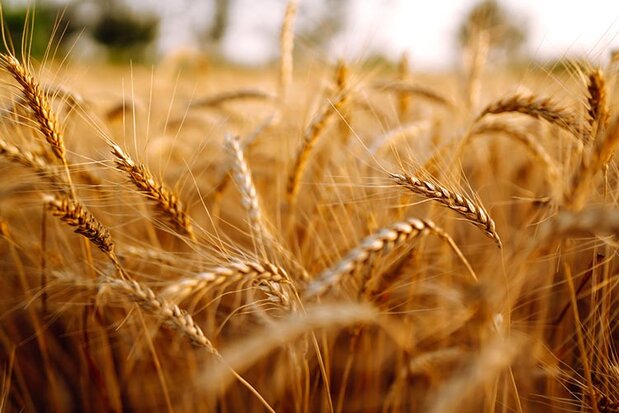
Whisk(e)y
See our guide on the difference between whisky and whiskey.
White Dog
An American term for New Make (see New Make).
White Oak
See American Oak.
Winter Wheat
A variety of Wheat, favoured for it has high levels of Starch and low levels of Protein. Winter Wheat is planted in Autumn and the crop is garnered late in the Summer of the following year.
Wood Finish
See Cask Finish.
Worm Tub
A coiled copper tube submerged within a large tub used to condense the gaseous alcohol vapours coming off the still. These are usually kept outdoors. Roughly ten Scotch distilleries still make use of Worm Tubs.
Wort
The liquid drawn from the Mash Tun after the mashing process is complete. Present now here are the sugars which will later be fermented with the addition of yeast.
Yeast (aka Barm)
A micro organism from the Fungi kingdom. Yeast is used in the fermentation process for it feeds on sugar and produces carbon dioxide and ethyl alcohol.
Yield
The amount of alcohol produced from a distillation. Technically speaking it is calculated as the quantity of alcohol produced from a ton of malt.
Our authors
Explore more
Sign up to our newsletter
Special offers, recommendations and expert advice to your inbox! Unsubscribe at any time.
I agree to the Privacy Policy












